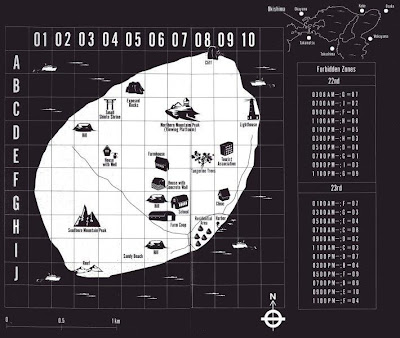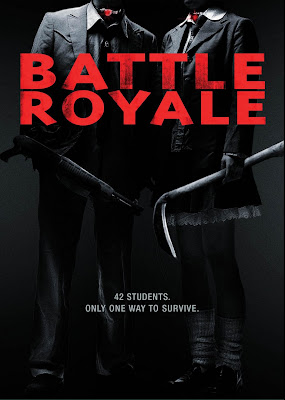In honor of the Dallas Film Festival (and an accounting error by my assistant, Allan Tam), the Film & Art Study began it's own "Reel FX Film Festival" the week of April 24, 2012, with a special UNRATED presentation of the Japanese film, Battle Royale.
Did you still feel “hungry” after Hunger Games? Perhaps the violence in Hunger Games was a little watered down for your taste? Maybe you need a satisfying evening with one of the highest grossing films in Japan!
R.L. Shaffer of IGN gave the film, Battle Royale, a score of 8 out of 10, taking "a moment to thank The Hunger Games for reminding us how awesome Battle Royale really is" and concluding that Battle Royale is "a masterpiece of mayhem, violence and unfettered teen melodrama."
Battle Royale is based on a Japanese novel written by Koushun Takami, completed in 1996 and published in 1999. The story tells of school-children who are forced to fight each other to the death. It is a metaphor for the anguish of adolescent existence and a commentary on a corrupted, centralized government in Japan.
Battle Royale takes place in an alternate timeline. Japan is a member region of a totalitarian state known as the Republic of Greater East Asia. Under the guise of a "study trip", a group of students from Shiroiwa Junior High School in the fictional town of Shiroiwa, in Kagawa Prefecture, are gassed on a bus. They awaken in the Okishima Island School on Okishima, an isolated, evacuated island southwest of Shodoshima. They learn that they have been placed in an event called the Program. Officially a military research project, it is a means of terrorizing the population, of creating such paranoia as to make organized insurgency impossible.
 |
| "Battle Royale" Map |
The first Program was held in 1947. According to the rules, fifty third-year junior high school classes are selected (prior to 1950, forty-seven classes were selected) annually to participate in the Program for research purposes. The students from a single class are isolated and are required to fight the other members of their class to the death. The Program ends when only one student remains, with that student being declared the winner. (Sound familiar??) Their movements are tracked by metal collars, which contain tracking and listening devices; if any student should attempt to escape the Program, or enter declared forbidden zones (which are randomly selected at the hours of 12 and 6, both a.m. and p.m.), a bomb will be detonated in the collar, killing the wearer. If no one dies within any 24-hour period, all collars will be detonated simultaneously and there will be no winner.
Fun Film Facts:
The town from which the ill-fated students in Battle Royale hail is called Shiroiwa, which translates as "Castle Rock", a possible reference to Stephen King as well as Lord of the Flies.
Kiriyama, the film's main villain, does not utter one word throughout the entire film. He does, however, make a noise through a megaphone at one point.
The magazine containing bomb-making instructions that is used by Shinji Mimura and his gang is titled "Hara Hara Tokei" ("The Ticking Clock"). This magazine is a real bomb-making magazine published by an anti-Japanese-Government activist group called Higashi Ajia Hannichi Buso Sensen (East Asia Anti-Japanese Armed Front) from the 1970s.
Every actor in the film did his/her own stunts! None of the cast had any stunt doubles, not even the lead, Tatsuya Fujiwara.
The film began its first general North American theatrical run at the Silent Movie Theater in Los Angeles, CA, on December 24, 2011, 11 years after its Japanese theatrical release.
Since its release, the novel and its film adaptation have had an influence on later works. These include filmmakers such as Quentin Tarantino, most notably his Kill Bill films; the character Gogo Yubari, played by Chiaki Kuriyama, is similar to the character she plays in the Battle Royale film, Takako Chigusa.
Kiriyama, the film's main villain, does not utter one word throughout the entire film. He does, however, make a noise through a megaphone at one point.
The magazine containing bomb-making instructions that is used by Shinji Mimura and his gang is titled "Hara Hara Tokei" ("The Ticking Clock"). This magazine is a real bomb-making magazine published by an anti-Japanese-Government activist group called Higashi Ajia Hannichi Buso Sensen (East Asia Anti-Japanese Armed Front) from the 1970s.
Every actor in the film did his/her own stunts! None of the cast had any stunt doubles, not even the lead, Tatsuya Fujiwara.
The film began its first general North American theatrical run at the Silent Movie Theater in Los Angeles, CA, on December 24, 2011, 11 years after its Japanese theatrical release.
Since its release, the novel and its film adaptation have had an influence on later works. These include filmmakers such as Quentin Tarantino, most notably his Kill Bill films; the character Gogo Yubari, played by Chiaki Kuriyama, is similar to the character she plays in the Battle Royale film, Takako Chigusa.
The 2008 American young adult novel The Hunger Games by Suzanne Collins has been accused of being strikingly similar to Battle Royale in terms of the basic plot premise and the world within the book. While Collins maintains that she "had never heard of that book until her book was turned in", Susan Dominus of The New York Times reports that "the parallels are striking enough that Collins's work has been savaged on the blogosphere as a baldfaced ripoff," but argued that "there are enough possible sources for the plot line that the two authors might well have hit on the same basic setup independently." The general consensus in the time since has been one of amicable controversy, especially since the release of The Hunger Games film adaptation. Battle Royale author Takami said he appreciated fans "standing up" for his book, but stated that he thinks "every novel has something to offer," and that if "readers find value in either book, that's all an author can ask for."
From Joshua Cornelius of The Film League:
"At a glance, Battle Royale seems
like any other entry in the myriad of splatstick Japanese horror films
to appear in the post-millennial age. That is until you realize that Battle Royale
was part of that very first wave. A trend-setter that ignited a fever
of interest over Japanese genre films in general and inspired an
entirely new crop of wacky genre exports. Some of which seem to have
been produced solely for export on the international market just so gaijin could shake their heads and muse, “Those wacky Japanese.”
What sets Battle Royale apart is
the pedigree attached to the production. For starters, the film is
based on an actual novel by Koushun Takami. Outside of it’s literary
cred, the film was directed by none other than the prolific and admired
Kinji Fukasaku. The director of the Japanese portion of Tora! Tora! Tora! was
in his late sixties when he decided on the film, which his son Kenta
wrote the screenplay for. Fukasaku managed to wrangle one of Japans
biggest comedian/actor/director/game show host/artist/writer, Takeshi
Kitano to play their teacher. The film also introduced most of the
world to Quentin Tarantino’s own Go-Go Yubari, Chiaki Kuriyama (Kill Bill).
 |
| "Go-go Yubari" from "Kill Bill" |
The concept of the film is scandalously simple and yet rife with social commentary; The millennial Japan of Battle Royale (hereafter BR)
is a nation at war with it’s own youth. They just don’t seem to
respect their elders, or the age old mores of the sequestered island
nation. The parents are afraid of their own children (read: change)
and, in an effort to curb their wicked ways, have enacted something
known as the “BR Act”. Their solution to the problem is to randomly
select a classroom of children each year and abandon them on an island
with an assortment of weapons. They must murder each other in the span
of three days, or else an explosive collar around their neck will
detonate. There can be only one winner.
Exactly what “lesson” the youth of Japan
are to take from this effort remains unspoken. All I know is it’s a
hell of a way to legitimize a film about children killing each other
with guns, swords and crossbows.
If you’re thinking the concept is a bit too
controversial even for the Japanese, you’d be right. The film was
blamed for inciting at least one heinous murder.
In turn, it ignited a controversy around the government’s role in
censoring sensationalist works. Though never specifically stated, the
film was likely never picked up for distribution in the United States
simply because no one wanted to deal with the backlash. The film
instead received a handful of screenings around the country.
Distributors set their sights on less controversial works in an attempt
to cash-in on the interest in Japanese genre films. As such, films
like Versus, Ichi the Killer, The Ring, The Grudge and Audition made their way into American distribution after having been given quite a wide berth by BR.
Anything’s acceptable as long as there’s a cartoonish amount of blood,
it seems. The downfall of BR seems to be entirely in tone. Had
Fukasaku leaned just a bit more towards farce, his own film might have
been slacking against the wall of your local franchise video chain.
Fear not, BR received a bit of
admiration in it’s own time too. The film was nominated for the
Japanese Academy Award in most major categories. Though the film was
Fukasaku’s last (more on that in another post) and most controversial,
he remains a respected and admired director in the eyes of fans around
the world. The film itself has even more recently been made available
on Blu-Ray and can be found cuddling next to the most recent Disney
production at your local Worst-Buy."
Other film trailers by director, Kinji Fukasaku:
Shin Jingi Naki Tatakai (New Battles without Honor and Humanity) - 1973
Tora! Tora! Tora! - 1970
Battle Royale was written by Koushun Takami & Kenta Fukasaku & directed by Kinji Fukasaku.
Not Rated, 114 min. (South Korea version: 120 min, Director’s Cut: 122 min.) Dolby Digital, Color, 1.85:1 Aspect Ratio.
Not Rated, 114 min. (South Korea version: 120 min, Director’s Cut: 122 min.) Dolby Digital, Color, 1.85:1 Aspect Ratio.










No comments:
Post a Comment